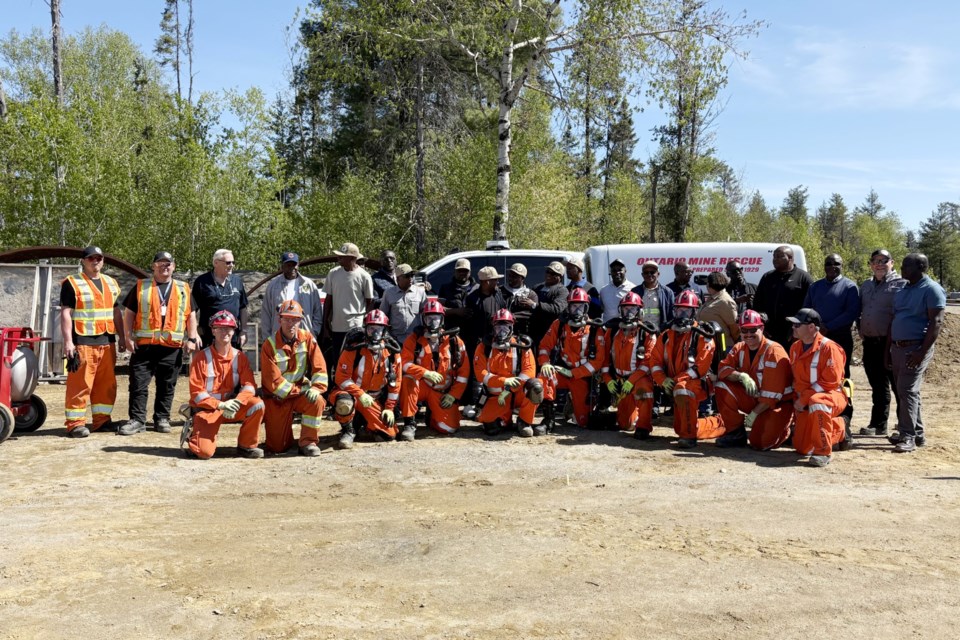A delegation of mining officials from the African republic of Zambia is in Sudbury this week to learn how Ontario Mine Rescue manages to run one of the most effective rescue services anywhere in the world.
Not that the Zambians don't have their own effective mine rescue service, something that is vital in a country that has significant copper mining operations along with cobalt, manganese, silver, iron, uranium, lead and zinc.
But Zambia is now planning to take to the world stage and host the 2026 international mine rescue competition on behalf of the International Mines Rescue Body (IMRB).
That's where Ontario can help, said Shawn Rideout, Ontario's chief mine rescue officer, based in Sudbury. Rideout is in the process of organizing the annual all-Ontario mine rescue competition that takes place next week in Timmins. And the Zambia delegation will be looking over his shoulder every step of the way.
Ontario Mine Rescue is a branch of Workplace Safety North, the Northern Ontario not-for-profit agency funded by the provincial government to provide health and safety training and services to the mining and forest products industries.
Ontario has mine rescue competitions every year in each of the eight mining districts across the province. Every company's mine rescue team is allowed to compete. Those events then progress to the all-Ontario competition; an intense three-day event that tests the best teams in Ontario on emergency rescue response, firefighting, first-aid, technical knowledge of specialized rescue tools, rope rescue techniques, ability to work for several hours in a hostile environment wearing special breathing apparatus, along with completing a written exam.
Rideout said the mine rescue organization in Zambia does not have annual competitions
"They want to host the international mine rescue competition in 2026 so they're here to learn about how a competition operates, what we do to plan for it, how we organize it, and how we execute it," said Rideout.
"And then next week, they're going to follow me to Timmins. And they're going to shadow us through the provincial competition … so they'll get to see firsthand exactly how things will roll out.”
He said part of the work with the Zambia delegation includes the administrative background work of staging a major competition along with giving the Onaping district team winners (Glencore Integrated Nickel Operations) a chance to refine their techniques in preparation for the provincial event.
Secrecy is another part of the event, said Rideout. He said none of the mine rescue officers has any clue of what the mock scenario will entail at the provincial competition. He said every competition has to be like that so no one gets an unfair advantage.
In terms of demonstrating or "showing off" the best feature of Ontario Mine Rescue, Rideout said hands down it is the standardization of the process.
Every mine rescue station in Ontario has the same rescue tools, the same breathing apparatuses, the same training procedures, the same stretchers. He said everything is the same even to the point of having specific tools that are the same colour, he said.
Rideout said a piece of standard equipment with a different colour can result in losing critical time if a mine rescuer doesn't recognize the tool or has to question why it is a different colour.
He said we can all drive a car, but if we have to use a rental car on a Monday morning, it will take a few extra minutes to figure out the controls for the lights, the horn, the wipers.
"It's the same thing with emergency response equipment," said Rideout.
"When it comes to a real emergency, it's second nature to grab it, use it, and be comfortable with it. Do something very simple. A backboard is a backboard. Change the color of it. Go from a yellow one to a blue one, and it's going to take a second or a question to say, "oh, do I know how to use that?’," he said.
He said standardization is critical in emergency situations.
Rideout said he wasn’t surprised when Zambia came calling, looking for guidance on their competition plans.
Rideout said Ontario is known globally for having effective mine rescue training and response. He said this also translates to international competitions where Ontario mine rescue procedures are copied and encouraged.
He said with so many Canadian companies operating in different jurisdictions, it is no surprise when mining executives call on Ontario Mine Rescue to serve their mining operations.
“So we're always being asked to help out,” said Rideout.
“I'd say the most significant one that we've done over the last decade is we've really helped Newfoundland and Labrador establish their mine rescue program,” he said.
“As of today, they are running the Ontario mine rescue program there, while in the background, they're kind of developing their own but they're referring to Ontario mine rescue and they're following all of our training materials. We've done the same thing in Ireland. We've done the same thing in Columbia.”
Rideout said he is confident that Ontario Mine Rescue could be an exportable and revenue-generating commodity, but for the fact that the industry is booming right now.
“We've explored that in the past. Our issue right now is just the amount of manpower that we have. Mining is booming in Ontario, so that's taking all of our resources.”
Len Gillis covers the mining industry along with health care news for Sudbury.com.




